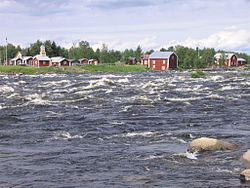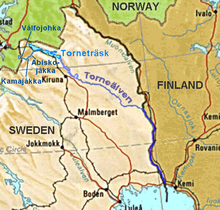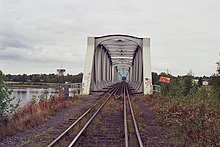Torne (Finnish and Swedish river)
| Torne river | |
|---|---|
 The Torne at Kukkola rapids north ofTornio | |
 Location of the Torne | |
| Location | |
| Countries | Norway (hydrological source) |
| Physical characteristics | |
| Source | Torne träskand its main affluent |
| • location | Kiruna Municipality,Norrbotten,Sweden |
| • coordinates | 68°22′N019°06′E/ 68.367°N 19.100°E |
| • elevation | 341 m (1,119 ft)(hydrological source 1189 m65°48′30″N24°8′45″E/ 65.80833°N 24.14583°E) |
| Mouth | Gulf of Bothnia |
• location | Tornio/Haparanda,Finland/Sweden |
• coordinates | 65°50′N024°09′E/ 65.833°N 24.150°E |
• elevation | 0 m (0 ft) |
| Length | 510 km (320 mi)[1]plus 110 km above the outlet of Torneträsk |
| Basin size | 40,157.1 km2(15,504.7 sq mi)[2] |
| Discharge | |
| • average | 370 m3/s (13,000 cu ft/s)[1] |
TheTorne,also known as theTornio(Finnish:Tornionjoki,Swedish:Torne älv,Torneälven,Northern Sami:Duortneseatnu,Meänkieli:Väylä), is a river in northern Sweden and Finland. For approximately half of its length, it defines the border between these two countries. In the upper parts, the river is situated in Sweden before it meets theMuonio Riverwhere it adjoins the international border. It rises at the lakeTorneträsknear the border withNorwayand flows generally southeast for a distance of 522 kilometres (324 mi) into theGulf of Bothnia.It is the largest river inNorrbotten Countyboth by length and by watershed area.
At its source, the Torne is located close to theNorth AtlanticandNarvikon the other side of the watershed, with several thousands of kilometres between the locations via waterways.
Geography
[edit]The Torne basin has a total area of 37,300 square kilometres (14,400 sq mi) or 40,147.1 square kilometres (15,500.9 sq mi) (see sidebar). Of this, 25,392.2 km2(9,804.0 sq mi)[3]or 25,393.1 km2(9,804.3 sq mi)[4]is inSweden,10,400 km2(4,000 sq mi)[5]or 14,266.3 km2(5,508.2 sq mi)[4]is inFinlandand 1,500 km2(580 sq mi)[5]or 497.7 km2(192.2 sq mi)[4]is inNorway.
Nominal source and hydrological source
[edit]The source of the Torne is generally believed to be the lakeTorneträsknear the border with Norway. But the main feeder of this lake isAbiskojåkka,flowing out ofAbiskojaure,which is mainly fed by Kamajåkka, coming from tributary Gamajávri. This lake's majortributaryis Válfojohka. That river comes from Lake Válfojávri in Norway'sNordland,but near to that lake it is joined by a nameless, longer stream, according to official Swedish maps fed by a small glacier, 1,189 m (3,901 ft) above sea level (68°16′02″N18°07′41″E/ 68.26722°N 18.12806°E).
Lake Torne
[edit]Other affluents of Lake Torne areNjuoraätnoandKåppasjåkkain the west,Gurttejohka,Snurrijåkka,Bessešjohka,Bággesgorsajohka,Davip Duoptejohka,Lulip Duoptejohka,Sarvájohkaand others in the north, andRákkasjohka,Gohpasjohka,Miellejohka,Bessešjohka,Golkkokjohka,Nivsakkjohkaand others in the south.[6] Above Torne lake, the watershed of the Torne includes the villagesRiksgränsen,Katterjåkk,Vassijaure,Låktatjåkka,KopperåsenandTornehamn. On the south shore of Torne lake areBjörkliden,Abisko,Stordalen,Kaisepakte.StenbackenandTorneträsk. On the north shore are theSamivillagesLaimoluoktaandKattuvuoma.[6]
Upper river
[edit]Beyond the lake, the Torne River flows unhindered by any concentrations of human inhabitants until the village ofKurravaara,around 12 kilometres (7 mi) northeast ofKiruna. The river splits in two parts that only join at Kurravaara;[7]the part between the river isAlajávri nature reserve. Between the lake and Kurravaara, the streamsČearrojogašandRávdojohkajoin on the right side, and shortly before Kurravaara, the 135-kilometre (84 mi) longRautas River flows into the Torne. On the left side, the streamsGukkajohka,ReaskkajohkaandDápmokjohkajoin. In the area between the two streams, theBeallejohkajoins the right arm from the left.[7]
After Kurravaara, the river proceedsLaxforsen,where it is joined from the right by theLuossajoki. Here is the first bridge over the river for the road leading from theE10to Laxforsen, Luossajärvi and Esrange.[8]The river continues toJukkasjärvi,where anice hotelis built in winter from the river ice.
To the Bifurcation
[edit]BeyondPaksuniemi,the river is joined by thePounujokifrom the right. AtVittangi,the 126-kilometre (78 mi) longVittangi river,[9]which passes byEsrange,joins from the left.[8] Here is the second river-crossing bridge, used by theE45toKaresuando. The river then proceeds toKuoksu,where it is crossed by the road toLainioandOksajärvi,and toJuopakosku,where theJunojokijoins from the left. AtJunosuando,the Torne river loses 56% of its water to theTärendö Riverin one of the fourbifurcationsin the watershed area.[4] Here is also a bridge for the road toKangosandParkolombolo;[8]this is the fourth bridge over the river.
Shortly after Junosuando, thePiipionjokijoins from the left and atPalokorva,the 260-kilometre (160 mi) long[9]Lainio Riverjoins from the left. In the Lainio River watershed are two more, smaller bifurcations: the lakesGoldajávri,Råstojaureflow toward contributaries of the Laino river as well as to the Norwegian streamsSignaldalselvaandRåstaelvarespectively.
Down to Pajala
[edit]Between Junosuando andPajala,theKäymäjokijoins from the left and theLiviöjokiand theMertajokijoin from the right. The villageAnttisis located on the left bank of the river, with Swedish roadRiksväg 395on the right bank; the fifth bridge connects Anttis to the main road.[8] Shortly after Pajala, the Torne river joins with the 380-kilometre (240 mi) longMuonio River,[9]the biggest contributary of the Torne river. Near Pajala are two more bridges going north.[8] North of this point, the Muonio river forms the border with Finland. From this point, the border with Finland is formed by the Torne river.
Lower river
[edit]

From here the river flows south along the Finno-Swedish border. This part is known asMeänmaaand is a popular tourist destination. Slightly south of Pajala is a border-crossing bridge for a road leading toKolari,the eighth bridge over the main river from the source. The river proceeds to the villageKassa.[10] At the village ofPello,which lies on both sides of the river, is a bridge between the two parts. The river continues south toSvanstein,crosses the arctic circle atJuoksengiand proceeds toNiskanpääandKuivakangas. InÖvertorneå(Finnish:Ylitornio) there is another bridge, the final road bridge before the sea. Here, the 127-kilometre (79 mi) longTengeliön Riverjoins from the (Finnish) left side.[citation needed] The river continues toHedenäsetandRisudden.
AtKarungi,theLiakanjokideparts from the Torne river and flows to theGulf of Bothniaindependently in Finland. From Karungi south, there are railways on both sides of the valley. AtKukkolaisKukkolaforsen,a rapids which is also a tourist attraction. Before finally arriving at the twin city of Haparanda/Tornio,it passes by the villagesVojakkalaand Mattila.
In the twin city of Haparanda/Tornio are four more bridges: one for cyclists and pedestrians, one for local traffic, one for theE4and the southernmost, last and 14th bridge over the Tornio river is adual gaugerailway bridge connecting the Swedish and Finnish railway systems.
History
[edit]Antti Keksi authored a poem about the 1677 river flood.
In theTreaty of Fredrikshamnin 1809, when Sweden lost the areas which constitute present-day Finland toImperial Russia,the river was together with theMuonio RiverandKönkämä Riverchosen as border between Sweden and the new RussianGrand Duchy of Finland,thus splitting theprovincesofLapplandandVästerbotten.
According to the treaty, the border shall follow the deepest part of the river. Near Haparanda/Tornio the border was fixed in the treaty, partly on land, so the city of Tornio would belong to Russia. Once every 25 years, a commission of Swedish and Finnish representatives shall review this border. This means that the border can move, such as in 2006 when such a border change was undertaken.
Natural history
[edit]Research on ice breakup on the river and onLake SuwainJapansuggested "global processes including climate change and variability are driving the long-term changes in ice seasonality."[11][12]
Culture
[edit]Historically, the language used on both sides of the river was Finnish. In the late 19th century, schools were opened in both countries. Then there was a decision to make the Swedish part of areaSwedishspeaking by teaching the school children only written Swedish and allowing only Swedish to be spoken during lessons, sometimes also during breaks. As an effect, during the second half of the 20th century, Swedish was the dominant language on the Swedish side. The Finnish spoken in informal conversation is similar on both sides of the river, although some newer words differ. To support the traditional language on the Swedish side a new written language has been devised,Meänkieli.On the Finnish side only Finnish is used in written communication. These two languages differ considerably in spelling.
See also
[edit]References
[edit]- ^ab"Torne älv".Nationalencyklopedin(in Swedish).Retrieved14 July2010.(subscription required)
- ^"Län och huvudavrinningsområden i Sverige"(PDF)(in Swedish).Swedish Meteorological and Hydrological Institute.Retrieved14 July2010.
- ^Norrbottens län
- ^abcdHuvudavrinningsområden på gränsen mellan Sverige, Norge och Finland
- ^abInternational river basins of the worldArchived2005-11-15 at theWayback Machine
- ^abLantmäteriets fjällkarta BD6 Abisko-Kebnekaise-Narvik
- ^abLantmäteriets fjällkarta BD4 Kiruna
- ^abcdeLantmäteriets Översiktkarta 1 Kiruna
- ^abcVattendragsregistret
- ^Swedish articlesv:Torneälven
- ^Sharma, Sapna; Magnuson, John J; Batt, Ryan D; Winslow, Luke A; Korhonen, Johanna; Aono, Yasuyuki (2016)."Direct observations of ice seasonality reveal changes in climate over the past 320–570 years".Scientific Reports.6:25061.doi:10.1038/srep25061.PMC4844970.PMID27113125.Article ID 25061.
- ^Bell, Jillian (2016-04-27)."Industrial Revolution strongly tied to earlier thaws, later freezes: study".CBC News.Retrieved2016-05-07.
External links
[edit]![]() Media related toTorne Riverat Wikimedia Commons
Media related toTorne Riverat Wikimedia Commons
